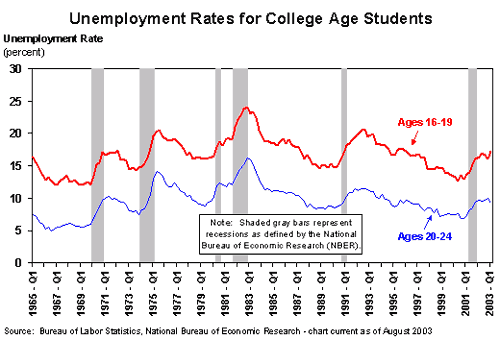Although it may seem at first glance that recessions and economic conditions may have little direct effect on college students, events in 2002 and early 2003 amply illustrate that the health of the economy can significantly impact college students. For example, the 2001 recession and the 2000 to 2002 bear market for stocks contributed to the widespread state budget crisis in 2003. The current budget crisis is having a real impact on public education in general, both at the college and the K-12 level. At the college level states trimmed educational services and raised student tuition and fees. The 2001 recession and resultant jobless recovery also affected the job market for students and graduates. So, let’s explore some of these effects in more detail.
Recessions, bear markets, and education budgets
Recessions—periods when economic output is falling rather than increasing—typically reduce tax revenues, especially income taxes and to a lesser extent sales taxes, while increasing government safety net spending (jobless benefits, health and welfare programs). Together these forces contribute to state budget shortfalls and lead to difficult funding decisions as exemplified by the 2003 funding cuts for state-supported colleges and universities, as well as cuts in support for students.
Chart 1

The downturn in the stock market from 2000 to 2002 (as shown in Chart 1) exacerbated the lingering negative effects of the 2001 recession on educational services and college students. The bear market resulted in a very unusual period of three consecutive annual declines in the stock market valuation and a loss on paper of approximately $6.7 trillion in market valuation from the March 2000 peak of $18.3 trillion until December 2002.1 The large cumulative decline in stock market valuation lowered earnings on capital gains and stock options to sharply reduce personal income and state tax receipts that help fund educational services.
The bear market also reduced the value of stocks held by some parents to support their children’s education and has lowered the returns on endowments that support education and programs at many colleges, private and public. Thus, some private colleges also may be experiencing a budget squeeze as a result of economic conditions.
Budget choices are difficult
Budget constraints can directly affect education and students in many ways.2 Course offerings, programs, and student activities may suffer cutbacks as programs compete for reduced funding. Funding opportunities for student loans, employment, and aid also may diminish. In the current budget shortfall, reduced funding has lead many colleges to increase tuition and fees as institutions struggle to make ends meet. However, these indirect effects of the recession on college programs are not the only ways that the downturn may have affected college students.
Chart 2

Job opportunities are scarce
As participants in the labor force, students also faced a more challenging economic environment during the 2001 recession and in the “jobless” expansion that began in November 2001 and continues into 2003. The 2001 recession resulted in a predictable increase in the unemployment rate for college-aged individuals. According to statistics reported by the National Center on Educational Statistics and the American Council on Education, about 80 percent of all undergraduates work while enrolled in college.3 As is illustrated in Chart 2, unemployment rates for individuals aged 16 to 19 and 20 to 24, the demographic groups that include most college students, typically rise sharply during recessions—represented by shaded columns on the chart—and into the early stages of a recovery. Not only current students have been affected, recent college graduates also have found fewer employment opportunities in the soft labor market. However, as the chart also shows, the jobless situation typically improves during an expansion.
Endnotes
1. Market capitalization figures from the New York Stock Exchange and NASDAQ.
2. As state and local jurisdictions struggle with deteriorating budget problems, they must make choices between a variety of spending programs, including support for higher education and college students. As noted in the March 2003, Western Economic Developments, “…state and local governments are instituting furloughs, salary cuts, and program reductions to balance state budgets. Several thousands government employees in the District received layoff warnings in recent weeks, giving them notice that their positions are dependent on resolution of the budget crises.”
3. Statistics from the 1999-2000 National Postsecondary Student Aid Study by the U.S. Department of Education’s National Center on Education Statistics and reported by the American Council on Education.
Further Resources
American Council on Education.
http://www.acenet.edu/home.html
“More must earn while they learn.” USA Today, April 22, 2003.
“Remedial Finance.” The Economist, May, 31, 2003.
“The Fiscal Survey of States.” National Governors Association and National Association of State Budget Officers, June 2003.
http://www.nga.org/cda/files/FSS0603.pdf
“Budget problems loom large in the West, economic impact less clear.” Western Economic Developments, Federal Reserve Bank of San Francisco, March 2003, pages 1-2.
/publications/economics/wed/index.html
Daly, Mary. “Understanding State Budget Troubles.” Economic Letter, Federal Reserve Bank of San Francisco, 2003-23; August 15, 2003.
/publications/economics/letter/2003/el2003-23.html